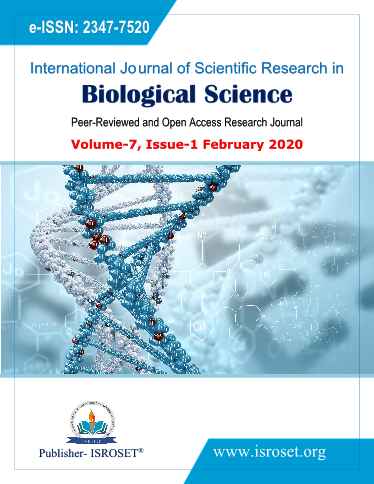Reproductive Functions and Toxicology Following Scrotal Ultrasound Therapy in Rats
Keywords:
Fertility, Scrotum, Ultrasound, ToxicologyAbstract
Therapeutic ultrasound involves direct application to the scrotum that might affect normal reproductive functions. We explore possibilities for development of a localized, non-invasive and reversible contraception method with ultrasound therapy in rat model. Animals were divided equally into five groups. Results observed with a gradual decrease in reproductive organs weight, testis volume, testosterone concentration and cauda epididymal sperm count, motility and viability following therapy, whereas sperm abnormalities were continuously enhanced throughout the study in groups II - V. Testis histopathology marked with duration and frequency dependent changes in groups II - V including conspicuous alterations in the seminiferous tubules, erupted germ cells, impaired spermatogenesis with pycnotic nuclei, vacuolization in the Sertoli cells, small Leydig cell nuclei, total necrosis and reduction in seminiferous tubules and wide interstitial space with fibroblast like cells. The fertility was totally lost at 180 days (groups II and III), 15 - 180 days (group IV) and 7 - 30 days of therapy (group V), respectively. A complete recovery was observed in all parameters in group V rats. Ultrasound application affects reproductive organs and fertility in rats. Hence, it may serve as a viable male contraceptive with further confirmation of dose and duration dependent efficacy, side effects and reversibility.
References
K. Bowler, “The Effect of Repeated Applications of Heat on Spermatogenesis in the Rat: A Histological Study,” Journal of Reproduction and Fertility, Vol. 28, Issue.3, pp.325-333, 1972.
M.S. Fahim, Z. Fahim , R. Der, D.G. Hall, J. Herman, “Heat in Male Contraception (Hot Water 60° C, Infrared, Microwave, and Ultrasound),” Contraception, Vol. 11, Issue.5, pp.549-562, 1975.
M.S. Fahim, Z. Fahim, J. Harman, I. Thompson, J. Montie, D. G. Hall, “Ultrasound as a New Method of Male Contraception,” Fertility and Sterility, Vol. 28, Issue.8, pp.823-831, 1977.
M.S. Fahim, Z. Fahim, F. Azzazi, “Effect of Ultrasound on Testicular Electrolytes (Sodium and Potassium),” Archives of Andrology, Vol. 1, Issue.2, pp.179-184, 1978.
A. Dumontier, A. Burdick, B. Ewigman, M.S. Fahim, “Effects of Sonication on Mature Rat Testes,” Fertility and Sterility, Vol. 28, Issue.2, pp.195-204, 1977.
R. Abadir, J. Harman, M.S. Fahim, “Enhancement of Ionizing Radiation Effect on the Testes of Rats by Microwave or Ultrasound-Induced Hyperthermia,” Journal of Medicine, Vol. 10, Issue.1-2, pp.1-12, 1979.
J.K. Tsuruta, P.A. Dayton, C.M. Gallippi, G.O. Michael, M.A. Streicker, R.C. Gessner, T.S. Gregory, E.J. Silva, K.G. Hamil, G.J. Moser, D.C. Skal, “Therapeutic Ultrasound as a Potential Male Contraceptive: Power, Frequency and Temperature Required to Deplete Rat Testes of Meiotic Cells and Epididymides of Sperm Determined Using a Commercially Available System,” Reproductive Biology and Endocrinology, Vol. 10, pp.7, 2012.
R. Leoci, G. Aiudi, S.A. De Sandro, F. Silvestre, F. Binetti, G.M. Lacalandra, “Ultrasound as a Mechanical Method for Male Dog Contraception,” Reproduction in Domestic Animals, Vol. 44, Suppl.2, pp.326-328, 2009.
R. Leoci, G. Aiudi, F. Silvestre, E.A. Lissner, F. Marino, G.M. Lacalandra, “Therapeutic Ultrasound as a Potential Male Dog Contraceptive: Determination of the Most Effective Application Protocol,” Reproduction in Domestic Animals Vol. 50, Issue.5, pp.712-718, 2015.
C. A. VandeVoort, T. L. Tollner, “The efficacy of ultrasound treatment as a Reversible Male Contraceptive in the Rhesus Monkey,” Reproductive Biology and Endocrinology Vol. 10, pp. 81, 2012.
CPCSEA, “Guidelines on the Regulation of Scientific Experiments on Animals. Standard Operating Procedures (SOP) for Institutional Animals Ethics Committee (IAEC)”, Animal Welfare Division, Ministry of Environment, Forests and Climate Change. Committee for the Purpose of Control and Supervision of Experiments on Animals (CPCSEA), New Delhi,” India, 2010.
WHO, “WHO Laboratory Manual for Examination and Processing of Human Semen,” 5th ed., World Health Organization (WHO), WHO Press, Department of Reproductive Health and Research, Geneva, 2010.
P. Taylor, “Practical Teratology,” Ed. 1, Academic Press, London, 1986.
M.S. Christian, “Test Methods for Assessing Female Reproductive and Developmental Toxicology,” Hayes AW (ed), Principles and Methods of Toxicology. Taylor and Francis Publishing, Philadelphia, pp.1301-1381, 2001.
M.J. Derelanko, C.S. Auletta, “Handbook of Toxicology,” Ed. 3, CRC Press, Taylor & Francis Group, Boca Raton, USA, pp.355-359, 2014.
V. Wasson, B. Singh, G. Wasson, “A Parallel Optimized Approach for Prostate Boundary Segmentation from Ultrasound Images,” International Journal of Scientific Research in Computer Science and Engineering, Vol.1, Issue.1, pp.14-19, 2013.
J.K. Tsuruta, P. Dayton, R. Gessner, T.S. Gregory, M. Streicker, G. Moser, E.J. Silva, D. Sokal, “Can Therapeutic Ultrasound be Used as a Reversible Male Contraceptive?,” In the proceedings of the International Ultrasonics Symposium (IUS), San Deigo, CA, USA, Oct 11-14, 2010.
Downloads
Published
How to Cite
Issue
Section
License

This work is licensed under a Creative Commons Attribution 4.0 International License.
Authors contributing to this journal agree to publish their articles under the Creative Commons Attribution 4.0 International License, allowing third parties to share their work (copy, distribute, transmit) and to adapt it, under the condition that the authors are given credit and that in the event of reuse or distribution, the terms of this license are made clear.







